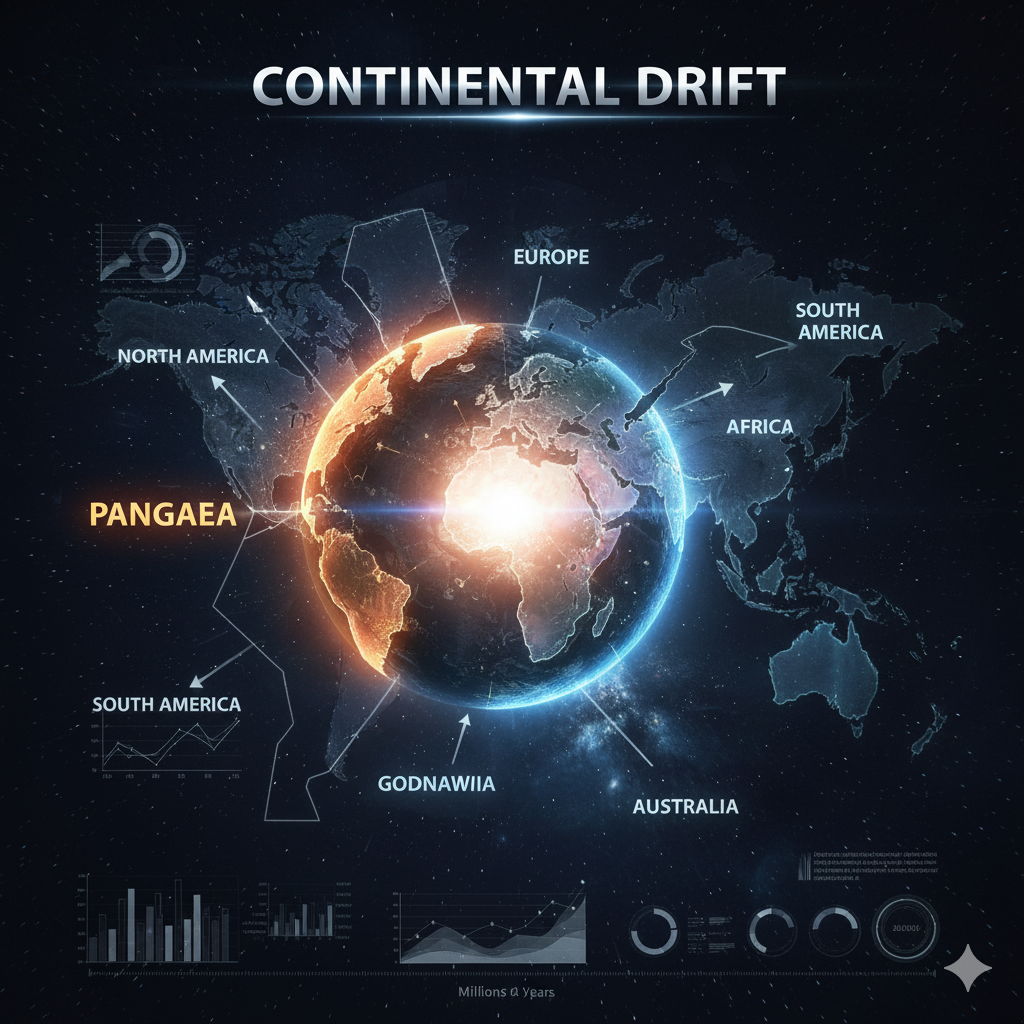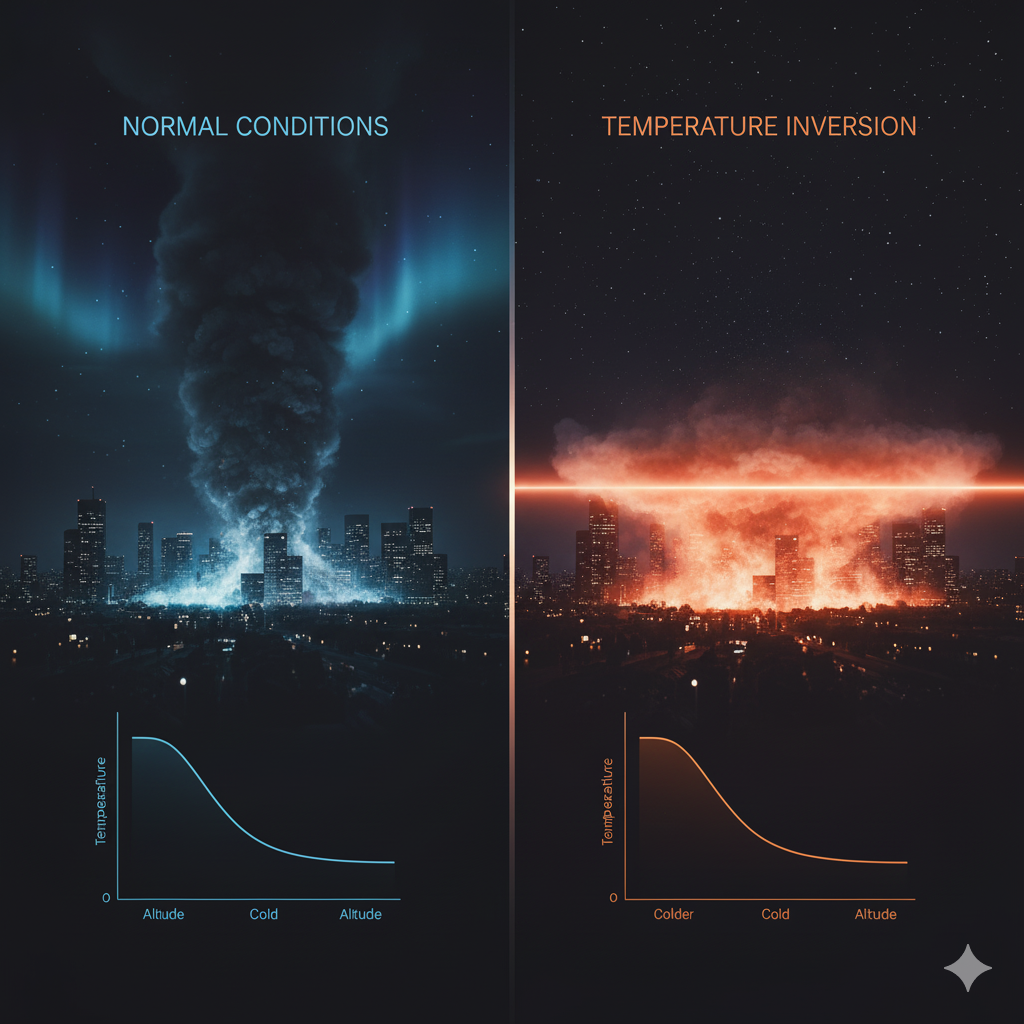Introduction
The theory of continental drift is one of the most significant scientific hypotheses in the field of geology and physical geography, explaining the past movements of the Earth’s landmasses and the formation of continents as we see them today. Proposed in the early 20th century, the theory revolutionized our understanding of Earth’s dynamic surface, laying the foundation for modern plate tectonics theory.
The central idea of continental drift is that the continents were not fixed, but rather drifted slowly over the Earth’s surface over geological time, leading to their current positions. This concept helped explain the apparent similarities in the geological structures, fossil records, and climatic conditions across continents now separated by vast oceans.
This essay aims to provide an in-depth understanding of the theory of continental drift, its origin, development, and the prominent evidences supporting it, with educational clarity suitable for students of geography, geology, and competitive exams.
1. Definition and Concept of Continental Drift
The theory of continental drift proposes that the Earth’s continents have moved over geological time and were once part of a single supercontinent, which gradually broke apart.
- The term “continental drift” was first introduced by the German meteorologist and geophysicist Alfred Wegener in 1912.
- Wegener suggested that all continents were initially joined together in a massive landmass called Pangaea, meaning “all lands.”
- Over millions of years, Pangaea gradually split, and its fragments drifted to form the current continents: Africa, Asia, Europe, North and South America, Antarctica, and Australia.
The theory challenged the then-dominant belief that continents and oceans were permanently fixed, proposing instead that the Earth’s surface is dynamic and constantly evolving.
2. Historical Background and Development
2.1 Early Observations
Before Wegener, several scientists had noticed similarities between continental coastlines, but no coherent theory explained these observations.
- Abraham Ortelius (1596) observed that the coasts of South America and Africa appeared to fit together like puzzle pieces.
- Antonio Snider-Pellegrini (1858) suggested that continents might have once been joined and later drifted apart, based on fossil evidence.
However, these early ideas lacked mechanistic explanations and were largely ignored by the scientific community.
2.2 Alfred Wegener’s Contribution
Alfred Wegener, in his 1912 publication “The Origin of Continents and Oceans,” presented a systematic theory of continental drift. He combined evidence from geology, paleontology, climatology, and oceanography to support his hypothesis.
Wegener’s key propositions were:
- The continents fit together like pieces of a jigsaw puzzle, especially the coasts of South America and Africa.
- Similar fossils and rock formations exist on continents now separated by oceans.
- Evidence of ancient climates suggested continents had moved from different climatic zones.
- The continents were once united in a single landmass, Pangaea, which later broke apart.
Despite the compelling evidence, Wegener faced criticism because he could not explain the exact mechanism that caused continents to drift.
3. Mechanism Proposed by Wegener
Wegener hypothesized that continental drift occurred due to forces such as:
- Centrifugal force of Earth’s rotation
- Gravitational forces of the Moon and Sun
- Tidal forces
He suggested that continents plowed through the oceanic crust, moving like icebergs through water. However, these explanations were later found inadequate, as the forces were too weak to move massive landmasses.
The actual mechanism for continental drift was discovered later through plate tectonics, which showed that lithospheric plates float on the semi-fluid asthenosphere and are moved by mantle convection, slab pull, and ridge push.
Despite the lack of a plausible mechanism, Wegener’s theory laid the groundwork for modern geology.
4. Evidences Supporting Continental Drift
The theory of continental drift is supported by multiple lines of evidence from geology, paleontology, climatology, and oceanography. These evidences are categorized below.
4.1 Geological Evidence
4.1.1 Fit of the Continents
One of the most striking evidences is the geometric fit of continental coastlines, particularly:
- The eastern coast of South America matches the western coast of Africa.
- Similar fits exist between Greenland, Europe, and North America.
This suggested that continents were once joined and later separated by drifting.
4.1.2 Similar Rock Formations
- Identical rock types, sequences, and geological structures are found on continents now separated by oceans.
- For example:
- Precambrian rocks of Brazil match those of West Africa.
- Mountain ranges like the Appalachians in North America and the Caledonides in Scotland and Scandinavia show similar age, structure, and rock types.
These correlations strongly indicate that these landmasses were once geologically continuous.
4.1.3 Matching Geological Structures
- Geological formations such as fold belts, ridges, and mineral belts continue across continental margins.
- Example: The Brazilian Shield and the West African Shield were once connected, as evident from the continuity of rock formations.
4.2 Paleontological Evidence (Fossil Records)
4.2.1 Distribution of Similar Fossils
- Fossils of identical species are found on continents now separated by oceans, which cannot be explained by land bridges alone.
- Examples include:
- Mesosaurus, a freshwater reptile, fossils are found in Brazil and South Africa.
- Lystrosaurus, a land reptile, fossils are found in Africa, India, and Antarctica.
- Glossopteris, a seed fern, fossils are found across South America, Africa, India, Australia, and Antarctica.
These findings suggest that these continents were once connected, allowing the free movement of species across a single landmass.
4.3 Paleoclimatic Evidence
Evidence from ancient climates supports continental drift:
4.3.1 Glacial Evidence
- Permian glacial deposits and striations (scratches on rocks) are found in South America, Africa, India, and Antarctica.
- The orientation of glacial striations suggests that glaciers radiated from a central landmass (Gondwana), implying that these continents were once connected near the South Pole.
4.3.2 Coal and Coral Deposits
- Coal deposits, indicative of tropical swamps, are found in North America and Europe, suggesting these continents were once located near the equator.
- Coral reefs, which require warm shallow seas, are found in areas currently in temperate or cold regions, further indicating continental movement over geological time.
4.4 Paleomagnetic Evidence
Paleomagnetism provided quantitative support for continental drift:
- Rocks contain magnetic minerals that align with the Earth’s magnetic field during formation.
- Studies revealed apparent polar wander paths, indicating that continents had shifted relative to the magnetic poles over time.
- This evidence confirmed that continents moved independently, rather than the poles themselves shifting.
4.5 Oceanographic and Seafloor Evidence
Though not available in Wegener’s time, later oceanographic studies reinforced continental drift:
- Mid-ocean ridges and seafloor spreading provided a mechanism for continental movement.
- The age of oceanic crust increases away from mid-ocean ridges, suggesting that continents are driven apart by new crust formation.
- Magnetic striping on the seafloor (alternating patterns of magnetic anomalies) indicates periodic geomagnetic reversals, supporting sea-floor spreading and continental drift.
These findings bridged the gap between Wegener’s hypothesis and the modern plate tectonics theory.
5. Significance of Continental Drift
5.1 Understanding Earth’s Geology
The theory explains:
- Formation of mountain ranges (e.g., Himalayas, Andes).
- Distribution of mineral resources.
- Alignment of ancient rock belts and structures across continents.
5.2 Evolution and Fossil Distribution
Continental drift explains the biogeographical distribution of species:
- Similar fossils across continents indicate past land connections.
- Provides insights into evolutionary pathways and migration of flora and fauna.
5.3 Climate Change over Geological Time
- Movement of continents explains shifts in climatic zones.
- Examples include glaciations in Gondwana and formation of desert belts as continents drifted to subtropical regions.
5.4 Foundation for Plate Tectonics
- Continental drift theory was the precursor to plate tectonics, which provides a mechanistic explanation for continental movement.
- Modern geology relies heavily on plate tectonics, integrating Wegener’s observational evidence with the physics of lithospheric plate motion.
6. Criticism and Limitations of Wegener’s Theory
Despite strong evidences, Wegener’s theory initially faced criticism:
- Lack of Mechanism: Critics argued that Wegener could not explain how massive continents moved through solid oceanic crust.
- Unrealistic Forces: Proposed forces (centrifugal and tidal) were too weak to overcome friction and resistance.
- Alternative Explanations: Geologists favored land bridges or other explanations for fossil similarities.
It was only in the 1960s, with discoveries in seafloor spreading and plate tectonics, that continental drift gained full acceptance.
7. Modern Understanding
Today, continental drift is understood within the framework of plate tectonics:
- The Earth’s lithosphere is divided into rigid plates.
- Plates move over the semi-fluid asthenosphere due to mantle convection, ridge push, and slab pull.
- Continents are embedded in these plates, drifting along with them.
- This explains Wegener’s observations, providing a mechanical foundation for continental drift.
8. Conclusion
The theory of continental drift proposed by Alfred Wegener marked a paradigm shift in geological sciences. By suggesting that continents were once joined in a supercontinent (Pangaea) and have drifted to their current positions, Wegener explained:
- The puzzle-like fit of continents
- Similar fossil records across oceans
- Matching geological formations
- Evidence of ancient climates inconsistent with current locations
Although initially criticized for lack of a convincing mechanism, the subsequent development of plate tectonics and seafloor spreading validated Wegener’s insights. Today, continental drift is recognized as a fundamental principle in understanding Earth’s dynamic geology, climate history, and evolution of life.
By studying continental drift, students gain insights into Earth’s ever-changing surface, the distribution of natural resources, and the interconnectedness of global ecosystems, highlighting the dynamic nature of our planet.




